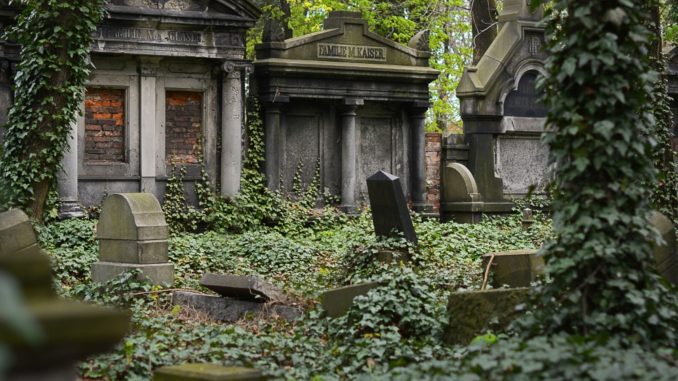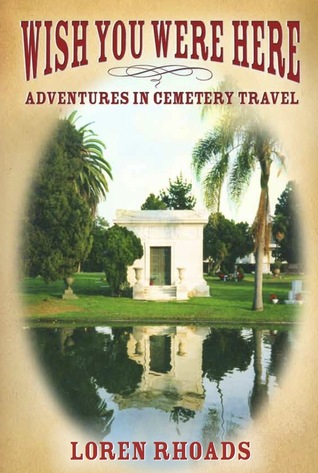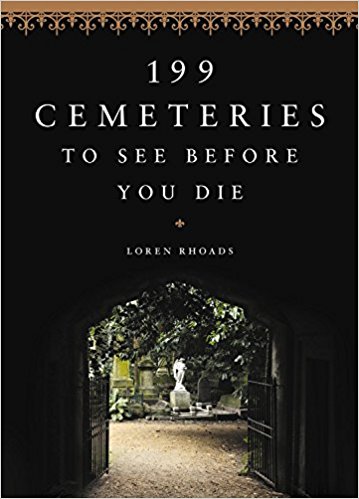
It’s been a busy February behind the scenes in the Library, so we weren’t able to do as much Women in Horror Month coverage/celebration as we would have liked, but we did get a chance to chat up one of our favourite authors, Loren Rhoads, who probably knows more about cemeteries and cemetery tourism than all of us combined. Need more persuasion? What if I told you she’s written Death’s Garden: Relationships with Cemeteries, 199 Cemeteries to See Before You Die and Wish You Were Here: Adventures in Cemetery Travel? Do I have your attention? Good. Let’s continue.
Loren, what first attracted you to places of mourning and eternal slumber?
Even before I started to travel to cemeteries, I was captivated by the artwork that appeared on the albums Within the Realm of a Dying Sun and Love will Tear Us Apart. I loved the statuary without realizing it came from Pere Lachaise and Staglieno cemeteries.
As I started to explore graveyards, I discovered that some cemeteries are basically open-air sculpture gardens. Daniel Chester French’s Angel of Death and the Sculptor at Forest Hills in Boston, Massachusetts also appears in the collection of the Metropolitan Museum of Art. William Wetmore Story’s Angel of Grief is a masterwork copied in graveyards around the world. Most of the major sculptors of the 19th and 20th centuries made grave monuments at some point or another.
So originally, before I knew anything about cemetery history, I fell in love with cemetery statuary. In a museum, the art is at arm’s length, behind barriers or on pedestals, out of reach. In a cemetery, there’s nothing between the viewer and the artwork.
 What’s been the most fascinating and rewarding aspect of your cemetery research for you?
What’s been the most fascinating and rewarding aspect of your cemetery research for you?
When I started studying cemeteries, I thought they were eternal monoliths. I quickly discovered that, in the West at least, beliefs about death have altered over the centuries. Burial grounds were once decorated with murals of the Danse Macabre, then by stones carved with Death’s-heads and crossbones, which softened into cherubs and angels. It’s rare to encounter embodiments of death in cemeteries anymore, but they’re still visible in postmortem photos on ceramic plaques or in the occasional sculpture that depicts Death, whether skeletal or angelic. I love that, although humans have been dying since time immemorial, our way of conceptualizing death keeps changing.
Having been to so many gravesites, how much difference is there in burial traditions between various countries and parts of the world?
That’s an enormous question. Not only do traditions vary from place to place, they differ from community to community and change over time. That’s why I can keep going to cemeteries, even though I’ve seen hundreds. I always find something different.
One brief illustration: graves in Japan are considered inviolable, so some continue to stand in Tokyo parks because they were built in historical times and couldn’t be moved when the parks opened more recently. Contrary to that reverence, graves are merely rented in some places in Southern Europe and South America. If the rent isn’t paid, the bones are removed and the graves reused. That’s true in the church-owned graveyards of New Orleans as well: some tombs are rented from the diocese, but rather than removing the bones, they are pushed back into a receptacle called a caveau where they combine with the remains of everyone else who’s ever been buried in that tomb. They just add another name to the grave slab.
Do you see evidence of our burial practices changing or evolving? If so, how?
The rise of cremation is already transforming graveyards by adding columbariums and scattering gardens. One of my favorite new graveyards is the Neptune Reef off the coast of Florida, where cremains (the remnants of human bodies after cremation) are mixed with cement to make sculptures that are sunk to the ocean floor to make a manmade reef. The reef has already been colonized by all kinds of sea creatures. I love the idea of using our deaths to improve the natural world.
Katrina Spade is working on a project to compost human bodies. She calls it recompositition. Here’s her TED talk: https://www.ted.com/talks/katrina_spade_when_i_die_recompose_me
There’s also a funeral home for pets in Seattle that is pioneering alkaline hydrolysis, a way of dissolving bodies down to fine sand. The process is less toxic for the environment than cremation. https://peacefulpetsaquamation.com/what-is-aquamation/
Finally, there’s green burial, where bodies are buried without embalming in shrouds or biodegradable wicker caskets. Graves are marked with boulders or trees, rather than the traditional monuments.
How we deal with our dead may change very greatly in the near future.
 How do people react when they discover the sorts of things you write about? Do they think it’s morbid or something strange for a woman to be interested in?
How do people react when they discover the sorts of things you write about? Do they think it’s morbid or something strange for a woman to be interested in?
When I started assembling the book Death’s Garden: Relationships with Cemeteries in the early ’90s, I hesitated to ask people for stories about graveyards they were familiar with. I was amazed to discover that almost everyone I spoke to had some place where they either had family buried or had played games growing up, or they’d visited on vacation or made a pilgrimage to a famous grave. The variety of connections people had made with cemeteries was a pleasant surprise.
Actually, cemeteries appeal to all kinds of people. This is how I put it in 199 Cemeteries to See Before You Die: “Why would anyone go out of the way to visit a graveyard intentionally? In addition to the fascinating stories they contain, cemeteries can be open-air sculpture parks full of one-of-a-kind artwork. They provide habitats for birds and wildlife, as well as arboretums and gardens of surprising beauty. Cemeteries appeal to art lovers, amateur sociologists, birdwatchers, master gardeners, historians, hikers, genealogists, picnickers, and anyone who just wants to stop and smell the roses. Our relationships with the places we visit can be deepened and enriched by learning the stories of those who came—and stayed—before us.”
Cemeteries themselves are working to change attitudes. Many work to bring people in, whether by offering tours or hosting performances or providing lectures. Cemeteries need people to visit, or else they are going to crumble away, unloved, and vanish. Which isn’t hyperbole: the historic cemeteries of the city where I live – San Francisco – were removed in the 1940s after being allowed to fall to ruin. The land was more valuable for housing, so the dead were evicted. Most of them, anyway. A little girl’s corpse was discovered in someone’s backyard in 2016, perfectly preserved in her beautiful casket. They reburied her in a newer cemetery last June.
The modern Death Positive movement is being led by women: Caitlin Doughty (star of the Ask a Mortician YouTube series), Sarah Chavez and Megan Rosenbloom (the administrators of the Death Salon). And there are the women who organize the Association for Gravestone Studies conferences as well as all the women cemetery bloggers and authors. Death used to be the traditional province of women, who washed and laid out the bodies. Once embalming became a “scientific” procedure, women were shut away from death, but reclaiming a relationship with the end of life is now seen as a feminist act.
So to answer your question, I forget that some people may consider my interests morbid. I see my curiosity – I’ve always seen it, in fact – as life-affirming. Cemeteries remind me that time is short. We are all going to die. I recognize that I don’t have a moment to lose.
For more, visit cemeterytravel.com





Leave a Reply